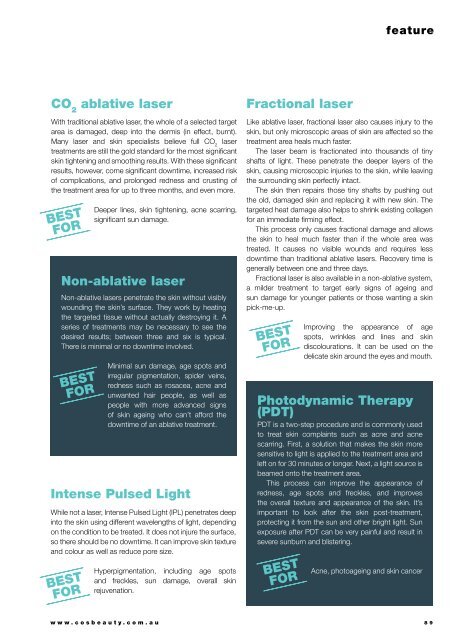Cosmetic Surgery and Beauty Magazine #67
Cosmetic Surgery and Beauty is the go-to magazine for anyone considering an aesthetic procedure. Covering a huge range of treatments with in-depth expert interviews and hundreds of before and after photos.
Cosmetic Surgery and Beauty is the go-to magazine for anyone considering an aesthetic procedure. Covering a huge range of treatments with in-depth expert interviews and hundreds of before and after photos.
You also want an ePaper? Increase the reach of your titles
YUMPU automatically turns print PDFs into web optimized ePapers that Google loves.
feature<br />
CO 2<br />
ablative laser<br />
With traditional ablative laser, the whole of a selected target<br />
area is damaged, deep into the dermis (in effect, burnt).<br />
Many laser <strong>and</strong> skin specialists believe full CO 2<br />
laser<br />
treatments are still the gold st<strong>and</strong>ard for the most significant<br />
skin tightening <strong>and</strong> smoothing results. With these significant<br />
results, however, come significant downtime, increased risk<br />
of complications, <strong>and</strong> prolonged redness <strong>and</strong> crusting of<br />
the treatment area for up to three months, <strong>and</strong> even more.<br />
BEST<br />
FOR<br />
Deeper lines, skin tightening, acne scarring,<br />
significant sun damage.<br />
Non-ablative laser<br />
Non-ablative lasers penetrate the skin without visibly<br />
wounding the skin’s surface. They work by heating<br />
the targeted tissue without actually destroying it. A<br />
series of treatments may be necessary to see the<br />
desired results; between three <strong>and</strong> six is typical.<br />
There is minimal or no downtime involved.<br />
BEST<br />
FOR<br />
Minimal sun damage, age spots <strong>and</strong><br />
irregular pigmentation, spider veins,<br />
redness such as rosacea, acne <strong>and</strong><br />
unwanted hair people, as well as<br />
people with more advanced signs<br />
of skin ageing who can’t afford the<br />
downtime of an ablative treatment.<br />
Intense Pulsed Light<br />
While not a laser, Intense Pulsed Light (IPL) penetrates deep<br />
into the skin using different wavelengths of light, depending<br />
on the condition to be treated. It does not injure the surface,<br />
so there should be no downtime. It can improve skin texture<br />
<strong>and</strong> colour as well as reduce pore size.<br />
BEST<br />
FOR<br />
Hyperpigmentation, including age spots<br />
<strong>and</strong> freckles, sun damage, overall skin<br />
rejuvenation.<br />
Fractional laser<br />
Like ablative laser, fractional laser also causes injury to the<br />
skin, but only microscopic areas of skin are affected so the<br />
treatment area heals much faster.<br />
The laser beam is fractionated into thous<strong>and</strong>s of tiny<br />
shafts of light. These penetrate the deeper layers of the<br />
skin, causing microscopic injuries to the skin, while leaving<br />
the surrounding skin perfectly intact.<br />
The skin then repairs those tiny shafts by pushing out<br />
the old, damaged skin <strong>and</strong> replacing it with new skin. The<br />
targeted heat damage also helps to shrink existing collagen<br />
for an immediate firming effect.<br />
This process only causes fractional damage <strong>and</strong> allows<br />
the skin to heal much faster than if the whole area was<br />
treated. It causes no visible wounds <strong>and</strong> requires less<br />
downtime than traditional ablative lasers. Recovery time is<br />
generally between one <strong>and</strong> three days.<br />
Fractional laser is also available in a non-ablative system,<br />
a milder treatment to target early signs of ageing <strong>and</strong><br />
sun damage for younger patients or those wanting a skin<br />
pick-me-up.<br />
BEST<br />
FOR<br />
Improving the appearance of age<br />
spots, wrinkles <strong>and</strong> lines <strong>and</strong> skin<br />
discolourations. It can be used on the<br />
delicate skin around the eyes <strong>and</strong> mouth.<br />
Photodynamic Therapy<br />
(PDT)<br />
PDT is a two-step procedure <strong>and</strong> is commonly used<br />
to treat skin complaints such as acne <strong>and</strong> acne<br />
scarring. First, a solution that makes the skin more<br />
sensitive to light is applied to the treatment area <strong>and</strong><br />
left on for 30 minutes or longer. Next, a light source is<br />
beamed onto the treatment area.<br />
This process can improve the appearance of<br />
redness, age spots <strong>and</strong> freckles, <strong>and</strong> improves<br />
the overall texture <strong>and</strong> appearance of the skin. It’s<br />
important to look after the skin post-treatment,<br />
protecting it from the sun <strong>and</strong> other bright light. Sun<br />
exposure after PDT can be very painful <strong>and</strong> result in<br />
severe sunburn <strong>and</strong> blistering.<br />
BEST<br />
FOR<br />
Acne, photoageing <strong>and</strong> skin cancer<br />
www.cosbeauty.com.au 89


















